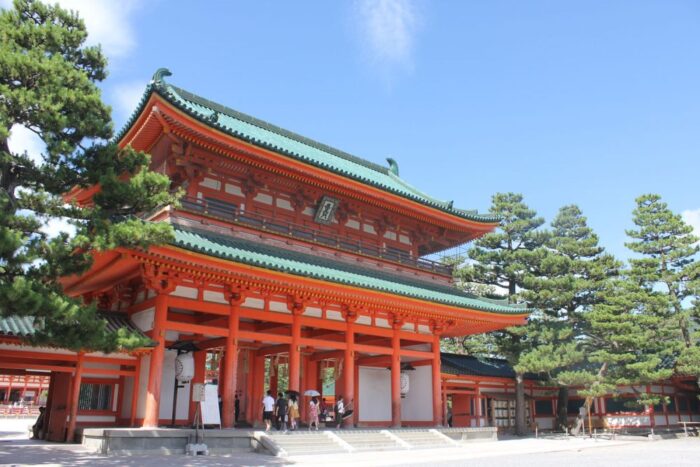The Heian Jingu shrine was instituted in 1895 to commemorate the 1,100-year anniversary of the return of the capital to Heian (today’s Kyoto). Heian Jingu was also built to consecrate Emperor Kanmu, as it was him who ordered this return. So you can imagine how important the shrine is for the city of Kyoto. Let’s learn more about this landmark!


Structures of Heian Jingu
In 1940, the spirit of Emperor Komei, the last emperor to live in the capital of Heian, was consecrated here together with Emperor Kanmu. Moreover, these figures and this sanctuary became widely revered as the deities of Japanese culture.
The main building of the sanctuary is a replica of the Chodoin, identical to the Heian Palace. It was built on a 5/8 scale of the original. The magnificent shape of the current sanctuary of Heian Jingu is composed of several original structures built in 1895, such as the Daigokuden (main hall), Outenmon Gate, and Soryuro, Byakkoro, corridors, and Ryubidan that have been renovated or rebuilt over the years.
In December 2010, Japan designated 6 structures, including the Daigokuden, as an Important Cultural Property along with the Great Shrine Gate (Otorii) 24.4 meters high along the road to the sanctuary, which was designated as Tangible Cultural Property.
Shin-en Garden
The Shin-en Garden within the grounds of the Heian Jingu Shrine is famous worldwide. It is one of the most famous gardens that was created during the Meiji period. The garden surrounds the main building of the sanctuary and consists of 4 parts. There are the Shin-en Higashi (east), Naka (center), Nishi (west), and Minami (south).
The vast garden was designed by the famous landscape gardener Jihei Ogawa VII. It is approximately 33,000 square meters and in its style presents a path around a pond. The garden was designated as a place of scenic beauty by the Japanese government in December 1975. It shows the spirit of all the gardening techniques that were collected during the 1,000 years in which Heian-kyo was the capital of Japan.



The magnificent Shin-en garden exhibits a different but equally charming side during each season, from cherry blossoms in spring, Japanese lilies in early summer, fall foliage in autumn, and snowy landscapes during winter. 100 years since its creation, today it became a space that invites visitors to the world of the Heian period and see the greatness of nature.
Torii Gate
With a height of 24.4 meters (80 feet), the large torii gate that extends on both sides of the sandō street of the Heian Shrine dominates the nearby horizon. Attracting visitors through Okazaki Park to the vermilion gate of the sanctuary, this torii was the largest in the country. While there are larger gates elsewhere now, it remains the tallest in Kyoto. Completed with special construction techniques to secure against earthquakes, the sturdy door legs are 3.6 meters (11.8 feet) in diameter.
Four Directions
Due in part to Chinese design, the influence of the divine beasts of the four cardinal directions. There are Suzaku the red phoenix (south), and Byakko the white tiger (west). Then there are Seiryū the blue dragon (east), and Genbu the black snake -turtle (north), abound in the sanctuary grounds. Once you enter the Ōtenmon Gate, you can see stone fountains that represent a tiger and a dragon on your left and right. And then you can see the ‘towers’ at the ends of the main hall. They are called Sōryūrō and Byakkorō, the ‘Tower of the Blue Dragon’ and the ‘White Tower of the Tiger’.
If you look more closely at the lanterns hanging on the eaves and the walkways, you will notice that the four gods also appear there. Their silhouettes are carved on the sides of the bronze lanterns. Heian Jingu is a great place to visit during your stay in Kyoto. It is a beautiful large place full of peace.
Your Japan Tour
As seasoned Japan experts, we create perfect Japan package tours including destinations like Kyoto. Check out our group tours and private tours, or contact us to start planning your unforgettable holiday to this fascinating country. Japan is full of once-in-a-lifetime experiences, culture, history, nature, and delicious food!
Heian Jingu Access Information
Access:
From Okazaki-Koen-Bijutsukan-Heianjingu-Mae bus stop or Higashiyama (Kyoto Subway) station
Hours:
From 6 am to 5 pm (subject to change by the season)

